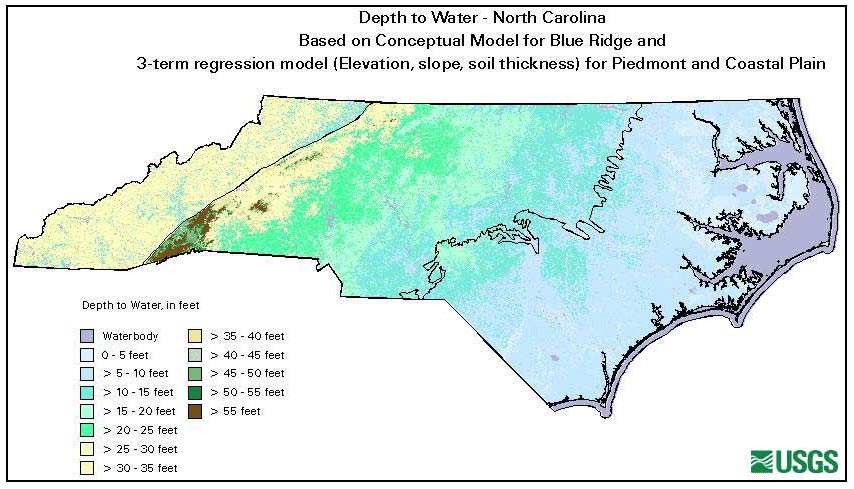Have you ever looked at your house and wondered why we have gutters? I know I have.
What’s wrong with water running straight off the house? Why do we need to catch it?
Most of the time I ask these questions when I see gutters damaged by the elements and beginning to separate from the house or water pouring out of a clogged one. Wouldn’t it be easier and more cost-effective if we didn’t have them at all?
If you’ve also had these questions, I’m here to tell you that you’re not alone. Many people have, but the reality is that the reason we have gutters is more than just the basic premise of diverting water away from your home, especially for those living in the Triangle, Triad, and overall Piedmont area.
In fact, that reason may be a bit more involved than you may think.
Soil Quality
When you look across the Piedmont region, there is a high concentration of clay in the soil. This is because of clay’s ability to retain water. The finer the soil particles, the more water molecules it can absorb. Because clay is so fine and has a high surface area it can absorb larger amounts of water.
But while clay soils retain more water, it can still push water away when there is too much moisture.

In order to manage mass amounts of water when it rains, you need to have a systematic solution to displace water toward places that have been set up to handle it. This is why we tend to see mass amounts of flooding after sustained, heavy rains.
Most homes send water via their gutters to the sewer drain in the road whether it’s through underground piping or a built-in decline in the landscaping or property layout.
Civil engineers are paid to figure out where to send runoff water through the designed topography of any given home, subdivision, or commercial property.
Water Table
Not only is the soil an issue, but the water table itself provides the next significant challenge.
If you look at the illustration ,

it shows that the depth needed to dig to get to water in the Piedmont region runs between 5 feet to 15 feet.
With this in mind, it is critical that our homes are set up to direct water in the proper direction toward designed areas prepared to handle large volumes. This is one reason Jordan Lake and other man-made regional lakes were created. Without proper planning, runoff water would force all of us to live a little differently than we’re used to.
Moisture
North Carolina, and more specifically Raleigh, on average receives 46 inches of rain per year along with an additional 4 inches of snow. The national rain average is 38 inches. 2019 has been the wettest year in Raleigh’s history with the Triangle receiving 59.2 inches of rain.
When an area has an overabundance of moisture it can cause many issues. Trees uproot easier, pavement damage and/or sinkholes emerge, and an overabundance of mold and moss grow to name just a few.
However, when gutters are properly used, many of the aforementioned issues aren’t totally avoided but they occur substantially less often.
Home Protection
Gutters make a significant difference in the surrounding area of your house and neighborhood and protect the home’s structure itself. If water ran where it wanted to, the potential for damage would be extremely high.
Not only would the home in general be under attack, but more importantly the foundation, studs, electronic components, and particleboard. Homes aren’t 100% waterproof and water tends to have a mind of its own. If there is a place water should not be, it will try to find a way to get there. In other words, water travels.

Exterior paint is another major victim of untamed water flow. When gutters divert water, the less exterior home surface is affected by the water flow during rain and melting snow, which helps the paint to last longer.
Gutter Damage Prevention and Care
With all of this in mind, there is a serious component of gutter care, which if done often and correctly, will prevent damage.
Healthy gutters should be free of gaps, holes, and clogs. Of those three issues, it is the clogs that can cause the biggest amount of damage. This can be triggered by leaves, pine cones, pine straw, and shingle grit.
If not cared for properly, a clogged gutter can do major damage as water will pool and the gutters themselves will begin to pull away from the house, damaging part of the roof and sending water down between the exterior siding and interior plywood. It can also allow the water to pool at the base of the house and begin eating away at the ground around the foundation.
Bottom line – if you don’t want to gut your bank account, take care of your gutters.
Hopefully, this helps to clarify why gutters are so important to our homes and their care can prevent major issues.
If you need help cleaning, repairing, replacing, or need additional gutter solutions, Chimneys Plus has professionals ready to serve. Give us a call and we will do our best to help you win in protecting your home for years to come.
Resources
Related Posts
Nothing found.

